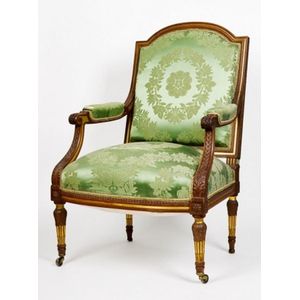Louis XVI Gilt Wood Settee with French Tapestry Upholstery
You must be a subscriber, and be logged in to view price and dealer details.
Subscribe Now to view actual auction price for this item
When you subscribe, you have the option of setting the currency in which to display prices to $Au, $US, $NZ or Stg.
- Giltwood - Giltwood is used to describe a gold finish on furniture and other decorative wooden items, whereby a thin sheet of gold metal, called gold leaf, is applied to the surface for decorative purposes.
Unlike gilding, where the gold leaf is applied over a coating of gesso, with giltwood the gold leaf is applied direct to the surface, or over a coat of linseed oil gold leaf adhesive.
Most gold-finished mirrors will be gilded, whereas furniture with gold highlights will have the gold applied through the giltwood method. - Rail - A term used by cabinet makers for the horizontal sections of the frame of an item such as a chair or settee which have a front rail, a back rail and two side rails, and also on a door or carcase, where the rails are joined to the vertical framings.
- Cresting - The decorative carving at the top of a piece of furniture, such as a sideboard back, a mirror, or a chair back.
- Fluting - A form of decoration found on many pieces of furniture, as well as ceramics, silver and clocks, in which round-bottomed grooves, of varying width and depth, are let into columns, pilasters, legs. As a general rule, flutes are cut in the vertical, though they may follow a turned leg in a spiral pattern. In cross-section, they may be described as a series of 'U' shapes, rising and narrowing at each end of the groove. Fluting is the opposite of reeding, with which fluting is often associated.
- Apron - A decorative wooden panel that sits underneath the top surface of a table or chair, and unites the top of the piece with the legs, running at right angles to the underside. On carcase furniture such as a chest or wardrobe, the apron sits below the drawers or doors and attaches to the legs.
On carcase furniture without legs the panel under the drawers or doors sits on the floor and is termed a plinth.
An apron can provide a decorative touch to an otherwise unadorned piece of furniture and at the same time provide structural support and strength. They can be carved or pierced and quite elaborate. - Foliate - Decorated with leaves or leaf-like forms.
This item has been included into following indexes:
- seating, lounges, settees and suites - couches, lounges and settees 288
- settees and sofas
Visually similar items

A pair of late 18th century Louis XVI parcel gilt bergeres attributed to Jean-Baptiste Claude Sene (1747-1803), back, padded arms and seat cushion upholstered in cream silk brocade on fluted supports, one stamped 'Sene' with incised Roman numeral I

A pair of late 19th century French Louis XVI style gilt wood fauteuils.

Pair of Louis XVI style carved walnut armchairs, carved walnut frames with gilt highlights, green silk damask upholstery (2). Height 102 cm

Salon chair. Early 20th century Louis XV style with tapestry
